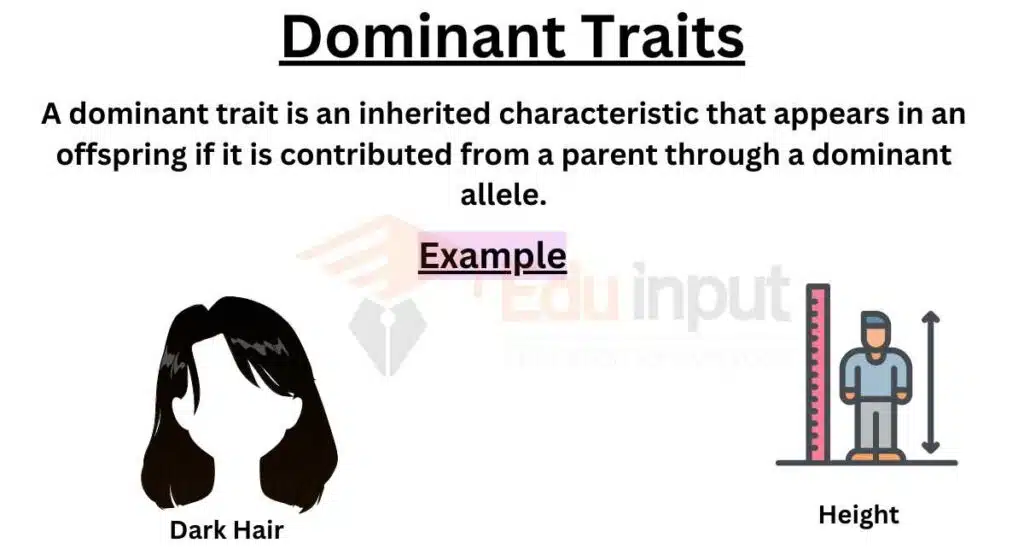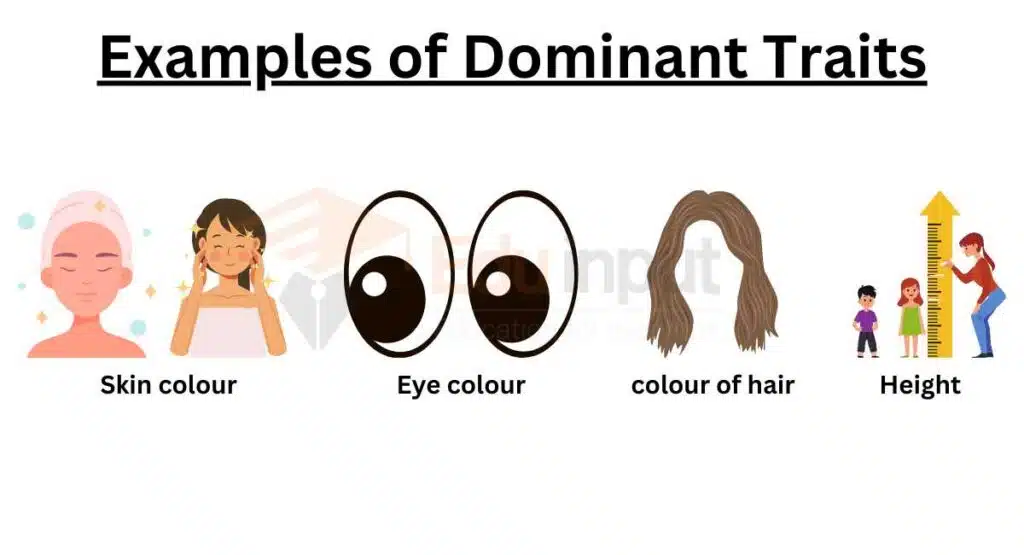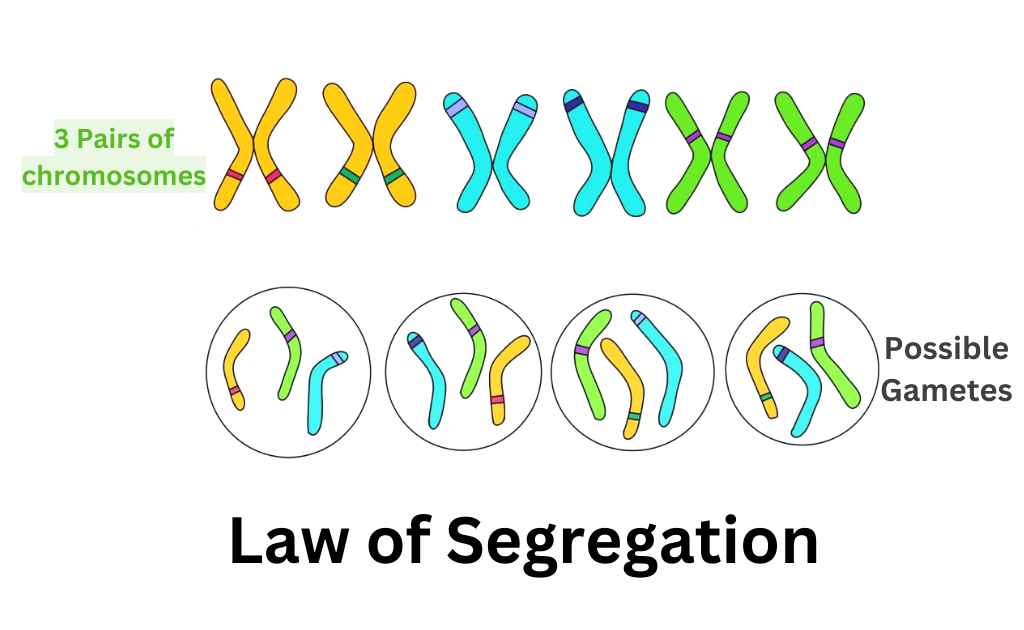Dominant Traits-Definition and Examples
In genetics, dominant traits are ones that show up when you have just one copy of a certain gene. You get two copies of each gene from your parents. If a trait is dominant, it means that having just one copy of the gene for that trait is enough to express it.

The other copy of the gene, called the recessive allele, doesn’t have an effect because the dominant allele masks it.
So, if you have one or two copies of the dominant allele, you will show the trait.
This is different from recessive traits, which need both copies of the gene to be present to show the trait.
Learn Differences Between Dominant And Recessive Traits
Examples to Understand Dominant Traits
Let’s imagine that we have a family with a mother and father who each carry two copies of the eye color gene. The mother has one copy of the brown eye allele (B) and one copy of the blue eye allele (b). While the father has two copies of the blue eye allele (bb).
Now, let’s see what eye color their children might have:
- First, we’ll look at the mother’s alleles: Bb.
- Then, we’ll consider the father’s alleles: bb.
Since brown eye color is dominant (B), having just one copy of the brown allele (B) is enough to express the brown eye color trait. However, blue eye color requires both copies of the blue allele (bb) to show the trait.
Possible Combinations Of Alleles For The Children
Child 1: Receives the brown allele (B) from the mother and the blue allele (b) from the father. The child has the genotype Bb and will have brown eyes because the dominant allele (B) is present.
Child 2: Receives the blue allele (b) from both the mother and the father. The child has the genotype bb and will have blue eyes because both alleles are recessive.
Even though the mother had one copy of the brown eye allele and one copy of the blue eye allele. Her children inherited either brown eyes (dominant trait) or blue eyes (recessive trait) depending on the combination of alleles they received.
What is Dominance?
Dominance is a key concept in genetics, where uppercase letters represent dominant alleles and lowercase letters represent recessive alleles.
For example, in peas, the dominant allele (R) for round shape masks the recessive allele (r) for wrinkled shape.
Dominance is relative, and one allele can be dominant over another but recessive to a different allele.
It differs from epistasis, where an allele of one gene masks the effects of alleles of another gene.
Dominant Traits and Alleles
In genetics, dominant traits and alleles refer to situations where having just one copy of the dominant allele is enough to show the trait.
The dominant allele masks the effect of the recessive allele. Usually, individuals with two dominant alleles or just one dominant allele will exhibit the same trait.
Here are examples of both dominant traits and alleles:
1. Dominant Trait-Brown Eye Color
- In humans, brown eye color is considered a dominant trait.
- If an individual inherits at least one copy of the dominant allele for brown eyes (B), they will have brown eyes.
- Even if they have one copy of the dominant allele (Bb), the trait will be expressed, and they will have brown eyes.
- Only individuals who carry two copies of the recessive allele for blue eyes (bb) will have blue eyes, as the dominant allele masks the effect of the recessive allele.

2. Dominant Allele-Hitchhiker’s Thumb
The ability to bend the thumb backward at a sharp angle is known as a dominant trait.
Individuals who possess at least one copy of the dominant allele (H) for hitchhiker’s thumb will exhibit this trait.
Even if they have one copy of the dominant allele (Hh), they will have the ability to bend their thumb backward.
Only individuals who carry two copies of the recessive allele (hh) will not have the ability to bend their thumb in this way.
21 Examples of Dominant traits in Humans
1. Dark hair is dominant over blonde or red hair.
2. Curly hair is dominant over straight hair.
3. Baldness is a dominant trait.
4. Having a widow’s peak (a V-shaped hairline) is dominant over having a straight hairline.
5. Freckles are dominant over no freckles.
6. Cleft chin is dominant over no cleft chin.
7. Dimples are dominant over no dimples.
8. Almond-shaped eyes are dominant over round eyes.
9. Having detached earlobes is dominant over attached earlobes.
10. Right-handedness is dominant over left-handedness.
11. The ability to roll the tongue is dominant over the inability to do so.
12. Astigmatism is dominant over normal vision.
13. The presence of webbed fingers is a dominant trait.
14. Having six fingers (hexadactyly) is dominant over having five fingers.
15. Brown eyes are dominant over blue eyes.
16. Male pattern baldness is dominant over no baldness.
17. Having a longer second toe is dominant over having a shorter second toe.
18. Having more than 10 fingers (polydactyly) is dominant over having 10 fingers.
19. Tone deafness is dominant over normal musical ability.
20. A bent pinkie finger is dominant over a straight pinkie finger.
21. The crossing of thumbs is dominant over the lack of crossed thumbs.
Latest Research About Dominant Traits
- Scientists have studied autosomal dominant, sex-limited inheritance—a mode of transmission different from X-linked inheritance—showcasing potential significance in human genetics and evident examples in animals, particularly in traits controlled by dominant genes. [1]
- Scientists have also explored the efficacy of dominant genes in resistance breeding against northern corn leaf blight (NCLB), showing their potential to reduce percent leaf area affected and increase yield under NCLB epidemic conditions. [2]
- Scientists have also investigated dominant traits in leaf hydraulic responses of perennial grass species along a precipitation gradient in eastern Australia, revealing trade-offs between drought tolerance and plant morphology. [3]







Leave a Reply